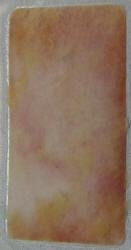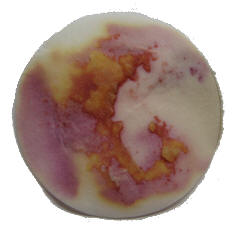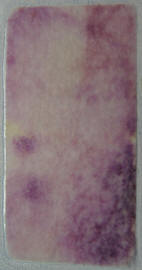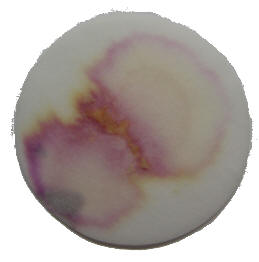Extraction of Garments
Control
experiments were carried to demonstrate negative reactions.
Fig. 5 shows women's underwear with typical vaginal
discharge, which was known to be negative for semen.
The zinc strip showed no color change when used to analyze
these garments, nor did it show any time dependency.
The Phosphatesmo test, on the other hand, started to turn
purple after 15 s, while the CheckMate® test started to
change after 10 minutes. The InSite AP strips did not
react at all (not pictured). This demonstrates that
vaginal acid phosphatase interferes with the detection of
seminal AP and will give a false positive test in as little
as 60 s. The garments were analyzed by wetting the
area of interest with 1-2 drops of water, and then pressing
test strips against the areas (zinc and Phosphatesmo) or by
pressing a filter paper circle against the area (followed by
a CheckMate® AP test).
In order to
determine how long semen can be detected on underwear, the
undergarments of a volunteer were analyzed at periods of
0-10, 10-17 and 17-34 hours after intercourse.
Fresh cotton underwear was worn during each time period.
The garments were analyzed using zinc strips, three acid
phosphatase tests (InSite® strips, CheckMate® and Phosphatesmo KM
brands), PSA strips
and semenogelin strips. The results from the zinc and AP tests are
shown in Fig. 6-7. The two acid phosphatase strips again proved
to be sensitive and convenient, yielding a dramatic purple reaction
after a few seconds. The CheckMate®
test took somewhat longer to turn blue, the reaction rate being
dependent on the freshness of reagents. The zinc test turned red when
pressed against the suspect area, but the result was not as
dramatic as the acid phosphatase tests. A PSA test
was performed for confirmation, showing a strongly positive
PSA test after 10 h (after 17 h the AP tests were done first
and soaked up inordinate amounts of material, which explains
the weak PSA). The zinc test was very slightly
positive after 34 h, while Phosphatesmo and CheckMate® were
judged to be negative. The PSA test was also very
slightly positive. (UV light was found not to be
useful in visualizing semen stains. These stains
appeared not to be fluorescent.)
The results from
the PSA and semenogelin tests are shown in Fig. 8.
PSA was detectable up to 32 h after intercourse, whereas semenogelin was detectable only up to 20 h. In
addition, the PSA strip had slightly better visibility. Since PSA strips are
1/10th the price of semenogelin strips, the former were
chosen for inclusion in the InSite kit.
The original
paper by Hooft et al
[Ref. 3] stated that
the zinc test was more sensitive and specific than the
classical AP test. This test was based on analyzing
vaginal swabs from a gynecologist's office, and also
evidentiary material from alleged sexual assaults (probably
also vaginal swabs). This method is much different
from analyzing women's underwear. Vaginal swabs
analyze source material deep in the vagina, whereas
underwear has absorbed whatever leaks out. Zinc is
probably much more concentrated in the vagina. In
addition, there was an unknown time period between sample
collection and laboratory analysis of the swabs, during
which time seminal proteins could have become denatured or
cleaved, releasing the zinc bound to them. Thus, these two
methods really aren't comparable.
Although
laboratory testing with zinc chloride has shown that the
limit of detection of the strips is approximately 0.01 mg/mL
of zinc, the limit of detection of semen is 1/200,
corresponding to a free zinc concentration of about 1 mg/mL
(assuming 200mg/mL in semen). This means that zinc is
probably 99% bound to proteins and other compounds in semen.
This is consistent with literature reports that zinc tends
to form complexes with other components of semen and that
after ejaculation, 50% is bound to seminal vesicle proteins
[Ref. 7].
These
results indicate that semen could be detected by the AP and
zinc tests
up to 17 h, and by the PSA and
semenogelin tests up to 36 h after intercourse. These
data are consistent with those reported in the literature, where
it is reported that
AP is generally not detectable beyond 12-18 h after
intercourse [Ref. 11], that
PSA levels return to baseline by 48 h
[Ref. 12], and that semenogelin has been detected up to 47 h
[Ref. 13]. This experiment
was repeated twice with identical results.
The volunteer
still had semen visible in her vagina after 36 h as a
stringy white substance; however, no marker proteins could be
detected. We attribute this observation to the
denaturization of seminal proteins by the acidic pH of the vagina (in a
fashion similar to egg whites when they are cooked), among
other factors.
|

|

|
|
Control
|
Control
|
|

|

|

|

|

|
|
Control zinc
|
Control
Phosphatesmo
15 s
|
Control
Phosphatesmo
60 s
|
Control
CheckMate®
15 s
|
Control
CheckMate®
20 m
|
Fig. 5. Control specimens of women's underwear showing typical vaginal discharge with negative test results.
|

|
|
0-10 h
|
|

|

|

|

|

|
|
zinc
pressed
0-10 h
|
Phosphatesmo
0-10 h
|
CheckMate®
0-10 h
|
PSA
0-10 h
|
zinc test
of extract
0-10 h
|
|

|

|

|

|
|
zinc
pressed
10-17 h
|
Phosphatesmo
10-17 h
|
CheckMate®
10-17 h
|
PSA
10-17 h
|
|

|

|

|

|
|
zinc
pressed
17-34 h
|
Phosphatesmo
17-34 h
|
CheckMate®
17-34 h
|
PSA
17-34 h
|
Fig. 6. Tests of women's underwear with zinc and AP tests, plus PSA for confirmation (note: there is no visual difference between control and test undergarments).